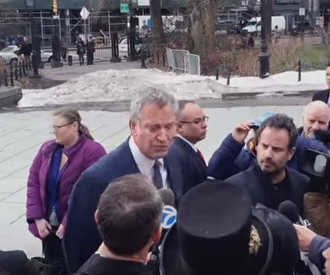
Movie Review: ‘The Last Horsemen of New York’
This documentary promised to bring the political battle surrounding New York City’s embattled carriage industry to the big screen. Does it live up to expectations? Biz Stamm reviews.
The Last Horsemen of New York is a documentary directed by Mary Haverstick that examines the embattled New York carriage industry and the drivers fighting to save their livelihoods. Our very own Kristen Kovatch has done some stellar reporting on this topic and I highly recommend checking out her article for some background before viewing this film.
Over the past several years, the New York City horse-drawn carriage industry has become the target of New York Mayor, Bill de Blasio. The topic came to the forefront during the 2013 mayoral race, and this film follows the debate from that point in time to where it currently stands today with a strong focus on the political motivation behind the ban.
The film begins aboard the carriage of Christina Hansen, one of the drivers prominently featured in this documentary. Hansen, one of the leaders in the pro-carriage horse movement shows up to be part of a fashion shoot only to be “greeted” by an angry mob of protesters, claiming the carriage industry is abusive to the horses it employs. From there, the film goes on to examine the political motivation underlying the cries of abuse on the surface of this proposed ban. While horses are at the heart of the issue, most of the film is spent examining government corruption and pay-for-play politics that surround this controversy.
Here’s the thing: whether you side with the carriage drivers or not, this film is biased as heck, which in my personal opinion does little to further the narrative or change minds. All the testimonials and coverage were devoted to the carriage drivers or those who support their cause, while absolutely zero time was given to the other side — or even impartial observers, for that matter. I would have loved to have heard from veterinarians, land use experts, economists, political analysts, demographers, or other equestrians with no stakes (financial or otherwise) in the New York carriage industry. It came across a bit like a pharmaceutical validation study conducted by the company attempting to profit off the drug in question. Regardless of the subject matter, I’m a big believer in an objective analysis of the facts, and I think an unbiased perspective would have made for a much more impactful piece.
On top of the overall biased nature, the structure of the film came across as quite repetitive with testimonial after testimonial covering many of the same points multiple times. The through line was somewhat difficult to follow as well, and I constantly found myself trying to locate the position of the story on the overall timeline.
As a horse lover, but maybe not someone super invested in the carriage industry, I walked away from the film feeling the need to fact check every piece of information conveyed over the course of the documentary. While one-sided coverage such as that featured in The Last Horsemen of New York may rile up the fervent supporters of the New York carriage industry, it will likely do nothing to sway the opinions of critics who can rightly point out the film’s biased nature as discrediting. While it was a valiant effort to passionately cover a controversial topic, the lopsided coverage let the film down leading me to give it 2 out of 5 carrots.









Leave a Comment